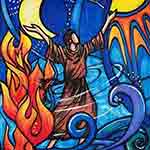In the month of September, and concluding on the feast of St Francis on October 4, many people focus on creation. A great starting resource for Christians and people of goodwill is the encyclical of Pope Francis, Laudato Si’. For Christians, creation is not merely an academic discussion about evolution or not – it is now, much more, seen as an essential part of mission, in partnership with others who share concern for “our common home”.
Here are resources from the Anglican Communion Environmental Network.
And from the Church of England Environment Programme.
This site is committed to the three year lectionary (RC) and its derivative, the Revised Common Lectionary (RCL). Rather than departing from that lectionary, resources have been provided on this site for a “creation reading” of our shared biblical texts. Here are creation reflections for this year, Year B. [This site also has such creation reflections for Years C and A].
The lectionary for year B (2018, 2021, 2024,…)
A creation reading of the lectionary for the Sunday between 4 and 10 September:
The Proverbs reading underscores that we are all creatures. Whether we claim more or less of creation, in fact none of us (but God) is over creation – we are all within it. In fact, our shared creature-hood is part of needing to treat other creatures equally, justly.
God’s mountains are a powerful metaphor for stability in Psalm 125.
The Isaiah reading has a number of images from creation, with a central focus on the importance of water.
Psalm 146 shows our connection to the earth, reinforces that it is God who made heaven and earth, the sea, and all that is in them, and also has a consequence on the responsibility to share.
Some of these threads are also woven into the text from the letter of James. Once again there is the acknowledgement of our duty to share and care within the creation God graciously gives.
The natural environment of Tyre, Sidon, the Sea of Galilee, and the region of the Decapolis form the frame for Mark’s story of a a Gentile woman, of Syrophoenician origin, to take on Jesus at his own craftsmanship of astute, witty repartee. Here, too, the question comes down to who can share in what of God’s natural provisions. The surprise in this text is that it is Jesus, for a change, who does not “win” this particular debate.
The additional value of using the agreed, shared texts of our three-year lectionary, rather than abandoning the lectionary to pick other, “convenient”, creation proof-texts using a concordance, is that by staying with the lectionary texts we demonstrate that creation is an integral thread woven through the whole Bible.
Liturgy for the Creation Season
Please add, in the comments below, any further creation insights from the lectionary readings, as well as other creation resources that will be useful this month. Some of these ideas will be added to the Creation Season resource page which I encourage you to also check out.
If you appreciated this post, consider signing up for a not-very-often email, and/or like the liturgy facebook page…




